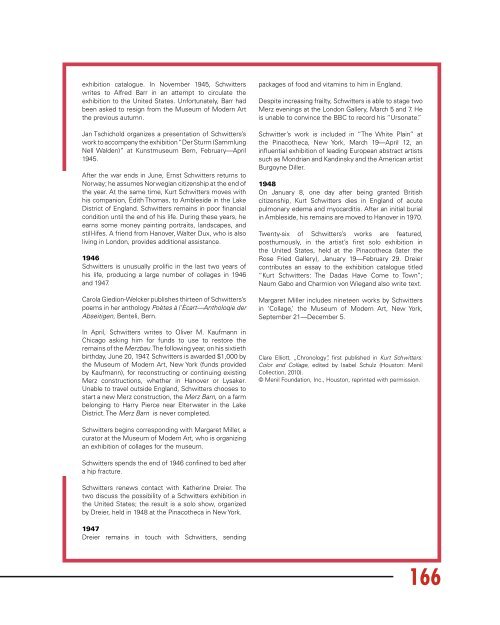Kurt Schwitters: Merz (2016) – Norman Rosenthal interviews Damien Hirst
Fully illustrated catalog published by Galerie Gmurzynska in collaboration with Cabaret Voltaire Zurich on the occasion of Kurt Schwitters: MERZ, a major retrospective exhibition celebrating 100 years of Dada. The exhibition builds and expands on the gallery’s five decade long exhibition history with the artist, featuring exhibition architecture by Zaha Hadid. Edited by Krystyna Gmurzynska and Mathias Rastorfer. First of three planned volumes containing original writings by Kurt Schwitters, historical essays by Ernst Schwitters, Ad Reinhardt and Werner Schmalenbach as well as text contributions by Siegfried Gohr, Adrian Notz, Jonathan Fineberg, Karin Orchard, and Flavin Judd. Foreword by Krystyna Gmurzynska and Mathias Rastorfer. Interview with Damien Hirst conducted by Norman Rosenthal. Includes full color plates and archival photographs. 174 pages, color and b/w illustrations. English. ISBN: 978-3-905792-33-1 The publication includes an Interview with Damien Hirst by Sir Norman Rosenthal about the importance of Kurt Schwitters's practice for Hirst's work.
Fully illustrated catalog published by Galerie Gmurzynska in collaboration with Cabaret Voltaire Zurich on the occasion of Kurt Schwitters: MERZ, a major retrospective exhibition celebrating 100 years of Dada. The exhibition builds and expands on the gallery’s five decade long exhibition history with the artist, featuring exhibition architecture by Zaha Hadid.
Edited by Krystyna Gmurzynska and Mathias Rastorfer.
First of three planned volumes containing original writings by Kurt Schwitters, historical essays by Ernst Schwitters, Ad Reinhardt and Werner Schmalenbach as well as text contributions by Siegfried Gohr, Adrian Notz, Jonathan Fineberg, Karin Orchard, and Flavin Judd.
Foreword by Krystyna Gmurzynska and Mathias Rastorfer.
Interview with Damien Hirst conducted by Norman Rosenthal.
Includes full color plates and archival photographs.
174 pages, color and b/w illustrations.
English.
ISBN:
978-3-905792-33-1
The publication includes an Interview with Damien Hirst by Sir Norman Rosenthal about the importance of Kurt Schwitters's practice for Hirst's work.
You also want an ePaper? Increase the reach of your titles
YUMPU automatically turns print PDFs into web optimized ePapers that Google loves.
exhibition catalogue. In November 1945, <strong>Schwitters</strong><br />
writes to Alfred Barr in an attempt to circulate the<br />
exhibition to the United States. Unfortunately, Barr had<br />
been asked to resign from the Museum of Modern Art<br />
the previous autumn.<br />
Jan Tschichold organizes a presentation of <strong>Schwitters</strong>’s<br />
work to accompany the exhibition “Der Sturm (Sammlung<br />
Nell Walden)” at Kunstmuseum Bern, February—April<br />
1945.<br />
After the war ends in June, Ernst <strong>Schwitters</strong> returns to<br />
Norway; he assumes Norwegian citizenship at the end of<br />
the year. At the same time, <strong>Kurt</strong> <strong>Schwitters</strong> moves with<br />
his companion, Edith Thomas, to Ambleside in the Lake<br />
District of England. <strong>Schwitters</strong> remains in poor financial<br />
condition until the end of his life. During these years, he<br />
earns some money painting portraits, landscapes, and<br />
still-lifes. A friend from Hanover, Walter Dux, who is also<br />
living in London, provides additional assistance.<br />
1946<br />
<strong>Schwitters</strong> is unusually prolific in the last two years of<br />
his life, producing a large number of collages in 1946<br />
and 1947.<br />
Carola Giedion-Welcker publishes thirteen of <strong>Schwitters</strong>’s<br />
poems in her anthology Poètes à l’Ècart—Antholoqie der<br />
Abseitigen, Benteli, Bern.<br />
In April, <strong>Schwitters</strong> writes to Oliver M. Kaufmann in<br />
Chicago asking him for funds to use to restore the<br />
remains of the <strong>Merz</strong>bau. The following year, on his sixtieth<br />
birthday, June 20, 1947, <strong>Schwitters</strong> is awarded $1,000 by<br />
the Museum of Modern Art, New York (funds provided<br />
by Kaufmann), for reconstructing or continuing existing<br />
<strong>Merz</strong> constructions, whether in Hanover or Lysaker.<br />
Unable to travel outside England, <strong>Schwitters</strong> chooses to<br />
start a new <strong>Merz</strong> construction, the <strong>Merz</strong> Barn, on a farm<br />
belonging to Harry Pierce near Elterwater in the Lake<br />
District. The <strong>Merz</strong> Barn is never completed.<br />
packages of food and vitamins to him in England.<br />
Despite increasing frailty, <strong>Schwitters</strong> is able to stage two<br />
<strong>Merz</strong> evenings at the London Gallery, March 5 and 7. He<br />
is unable to convince the BBC to record his “Ursonate.”<br />
Schwitter’s work is included in “The White Plain” at<br />
the Pinacotheca, New York, March 19—April 12, an<br />
influential exhibition of leading European abstract artists<br />
such as Mondrian and Kandinsky and the American artist<br />
Burgoyne Diller.<br />
1948<br />
On January 8, one day after being granted British<br />
citizenship, <strong>Kurt</strong> <strong>Schwitters</strong> dies in England of acute<br />
pulmonary edema and myocarditis. After an initial burial<br />
in Ambleside, his remains are moved to Hanover in 1970.<br />
Twenty-six of <strong>Schwitters</strong>’s works are featured,<br />
posthumously, in the artist’s first solo exhibition in<br />
the United States, held at the Pinacotheca (later the<br />
Rose Fried Gallery), January 19—February 29. Dreier<br />
contributes an essay to the exhibition catalogue titled<br />
“<strong>Kurt</strong> <strong>Schwitters</strong>: The Dadas Have Come to Town”;<br />
Naum Gabo and Charmion von Wiegand also write text.<br />
Margaret Miller includes nineteen works by <strong>Schwitters</strong><br />
in ‘Collage,’ the Museum of Modern Art, New York,<br />
September 21—December 5.<br />
Clare Elliott, „Chronology”, first published in <strong>Kurt</strong> <strong>Schwitters</strong>:<br />
Color and Collage, edited by Isabel Schulz (Houston: Menil<br />
Collection, 2010).<br />
© Menil Foundation, Inc., Houston, reprinted with permission.<br />
<strong>Schwitters</strong> begins corresponding with Margaret Miller, a<br />
curator at the Museum of Modern Art, who is organizing<br />
an exhibition of collages for the museum.<br />
<strong>Schwitters</strong> spends the end of 1946 confined to bed after<br />
a hip fracture.<br />
<strong>Schwitters</strong> renews contact with Katherine Dreier. The<br />
two discuss the possibility of a <strong>Schwitters</strong> exhibition in<br />
the United States; the result is a solo show, organized<br />
by Dreier, held in 1948 at the Pinacotheca in New York.<br />
1947<br />
Dreier remains in touch with <strong>Schwitters</strong>, sending<br />
166

















